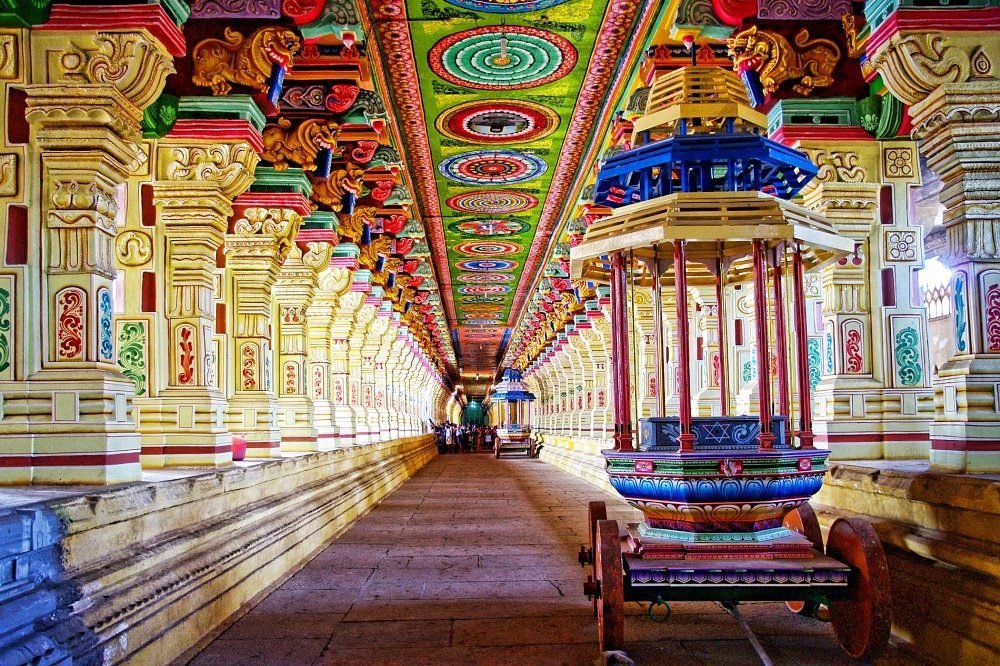The Ramanathaswamy Temple (Rāmanātasvāmi Kōyil) is a Hindu temple dedicated to the god Shiva located on Rameswaram Island in the state of Tamil Nadu, India. It is also one of the twelve temples in Jyotirlinga. It is one of the 275 Paadal Petra Sthalams, where the three most revered Nayanars (Saivite saints), Appar, Sundarar and Tirugnana Sambandar, have glorified the temple with their songs. The temple was expanded during the 12th century by the Pandya dynasty, and the main shrine shrine was renovated by Jeyaveera Cinkaiariyan and his successor Gunaveera Cinkaiariyan from the kingdom of Jaffna. The temple has the longest corridor among all the Hindu temples in India. The temple is located in Rameswaram considered a sacred pilgrimage site for Shaivites, Vaishnavites and Smarthas. The presiding deity, the Lingam of Ramanathaswamy (Shiva), was established and worshiped by Rama before crossing the bridge from him to Lanka.
Legend
According to the Ramayana, Rama, who is the seventh avatar of the god Vishnu, prayed to the god Shiva to absolve him of the sin of killing a Brahmin committed during the war against King Rakshasa Ravana (who was a Brahmin, son of a vedic rishi in Sri Lanka. Rama wanted to have a great lingam to worship Shiva. He ordered Hanuman, his army lieutenant, to bring a lingam from the Himalayas. When Hanuman was late in bringing the lingam, devi Sita built a small lingam from the sand available on the seashore, which is believed to be the lingam at the shrine.
Architecture
The main deity of the temple is Ramanathaswamy (Shiva) in the form of a lingam. There are two lingams within the shrine: one built by Rama, of sand, who resides as the main deity, Ramalingam, and the one brought by Hanuman from Kailash called Vishwalingam. Rama instructed that the Vishwalingam should be worshiped first, as it was brought by Hanuman; the tradition continues even today.
Like all ancient temples in South India, there is a high compound wall (madil) on all four sides of the temple compound measuring approximately 865 feet long from east to west and a furlong of 657 feet from north to south with huge towers (Gopurams) to the east and west and finished gate towers to the north and south. The temple has long, gaudy hallways inside, running between massive colonnades on platforms over five feet high.
The second corridor is made up of pillars, beams and a sandstone roof. The crossing of the third corridor in the west and the paved path leading from the western gopuram to the Setumadhava shrine forms a unique checkerboard-shaped structure, popularly known as Chokkattan Madapam, where the deities of Utsava are adorned and kept during the Vasanthotsavam (spring festival) and the sixth day festival in Adi (July-August) and Masi (February-March) led by Setupati of Ramnad.
The outer set of corridors is reputed to be the longest in the world, measuring about 6.9 m in height, 400 feet each in the east and west, and about 640 feet in the north and south. The interior corridors measure approximately 224 feet each in the east and west and approximately 352 feet each in the north and south. Its width ranges from 15.5 feet to 17 feet in the east and west to around 172 feet in the north and south with a width ranging from 14.5 feet to 17 feet. The total length of these aisles is therefore 3850 feet. There are about 1212 pillars in the outer corridor. Its height is about 30 feet from the ground to the center of the ceiling. The main tower or rajagopuram is 53 m high. Most of the pillars are carved with individual compositions. In the beginning, the Ramanathaswamy temple was a thatched roof shed. The current structure was the work of many people spread over several centuries. The place of honor in the establishment of the Temple is for the Setupatis of Ramanathapuram. In the 17th century, Dalavai Setupati built a part of the main eastern Gopuram. At the end of the 18th century, the third world-famous corridor was built by Muthuramalinga Setupati, who lived for forty-nine years and ruled between 1763 and 1795. The corridor was called “Chokkatan Mandapam”. The Mukhya Pradhani (Chief Minister) was Muthuirullappa Pillai and the Chinna Pradhani was Krishna Iyengar. The statue of Setupati and those of his two Pradhanis (ministers) can be seen at the western entrance of the third corridor.
The composite columns of Virabhadra holding the sword and horn are found as additions to the Vijayanayagara kings in the early 16th century. Similar columns of Virabhadra are found in the Adikesava Perumal temple in Thiruvattaru, the Meenakshi temple in Madurai, the Nellaiappar temple in Tirunelveli, the Kasi Viswanathar temple in Tenkasi, the Krishnapuram Venkatachalapathy temple, the Soundaradikombumal temple, Thaundaradjaperumal temple the Srdalivarmutamunta temple, the Sriknativa Perumal temple in Thadikombu. Temple of Vaishnava Nambi and Thirukurungudivalli Nachiar in Thirukkurungudi.
There are separate shrines for Ramanathaswamy and his goddess consort Parvathavardhini separated by a hall. There are separate shrines for the goddess Vishalakshi, the utsava images, sayanagriha, Vishnu, and Ganesha. There are several rooms within the temple, namely Anuppu Mandapam, Sukravara Mandapam, Setupati Mandapam, Kalyana Mandapam, and Nandi Mandapam.
Tirathas of Rameswaram
There are sixty-four Tīrthas (holy water bodies) in and around the island of Rameswaram, Tamil Nadu, India. According to Skānda Purāṇa, twenty-four of them are important. Bathing in these Tīrthas is a major aspect of the pilgrimage to Rameswaram and is considered equivalent to penance. Twenty-two of the Tīrthas are within the Rāmanāthasvāmī Temple. The number 22 indicates the 22 arrows in Rama’s quiver. The first and major one is called Agni Theertham, the sea (Bay of Bengal).
Rameswaram is one of the few temples that has the distinction of being the stala, Murthy, Theertham. Ramanathaswamy Temple Theertham is very special. There are 22 theerthams in the form of a pond and a well. These 22 theerthams represent the 22 arrows of Sri Rama.
It is said that every devotee should bathe in these theerthams before going to the sanctum sanctorum of the temple. Hanuman’s tail scar can still be seen on this Shivalinga. There are historical references that this is a tail scar trace that occurred when trying to remove the Ramalingam to dedicate the lingam brought from Hanuman Kasi.
Jyotirlinga
According to Shiv Mahapuran, once Brahma (the Hindu god of creation) and Vishnu (the Hindu god of salvation) had an argument in terms of the supremacy of creation. To test them, Shiva traversed the three worlds as a huge pillar of endless light, the jyotirlinga. Vishnu and Brahma work their way down and up respectively to find the end of the light in both directions. Brahma lied saying that he discovered the end, while Vishnu admitted his defeat. Shiva appeared as a second pillar of light and cursed Brahma telling him that he would have no place in the ceremonies while Vishnu would be worshiped until the end of eternity. The jyotirlinga is the supreme reality without parts, of which Shiva appears in part. Jyothirlinga shrines, therefore, are places where Shiva appeared as a column of fiery light. Originally, it was believed that there were 64 jyothirlingas, of which 12 are considered very auspicious and sacred. Each of the twelve jyothirlinga sites is named after the presiding deity, each considered a different manifestation of Shiva. [20] At all these sites, the main image is the lingam representing the Stambha pillar, symbolizing the infinite nature of Shiva (without beginning or end). The twelve jyothirlinga are Somnath in Gujarat, Mallikarjuna in Srisailam in Andhra Pradesh, Mahakaleswar in Ujjain in Madhya Pradesh, Omkareshwar in Madhya Pradesh, Kedarnath in the Himalayas, Bhimashankar in Maharashtra, Viswanath in Varanasi, Maharashan Varoghand in Urarashtra, Varogharhand Juarezhand in Umarashtra, Varogharhand Juarezhand in Umarashtra, Varogharhand Nageswar in Dwarka in Gujarat, Rameshwar in Rameswaram in Tamil Nadu and Grishneshwar in Aurangabad, Maharashtra. The temple is the southernmost of the twelve Jyothirlingas.
Contributions to the temple and donations from kings
The temple in its current form is believed to have been built during the 17th century, while Fergusson believes that the small vimana in the west corridor belongs to the 11th or 12th centuries. The construction of the temple is said to have been approved by King Kizhavan Sethupathi or Raghunatha Kilavan. The contribution of the Jaffna kings of the Sethupathy dynasty to the temple was considerable. King Jeyaveera Cinkaiariyan (1380-1410 AD) sent stone blocks from the Koneswaram Temple, Trincomalee, to renovate the temple’s sanctum sanctorum. Jeyaveera Cinkaiariyan’s successor, Gunaveera Cinkaiariyan, a Rameswaram trustee who also oversaw the structural development of this temple and the promotion of Saivite beliefs, donated part of his income to Koneswaram. Especially to remember are the immense sums that were spent during Pradani Muthirulappa Pillai’s tenure for the restoration of the Pagodas that were falling into ruins and the splendid Chockattan Mantapam or the cloistered enclosures of the temple at Rameswaram that he eventually completed. The rulers of Sri Lanka also contributed to the temple; Parakrama Bahu (1153-1186 CE) participated in the construction of the sanctum sanctorum of the temple. In addition, the King of Sri Lanka, Nissanka Malla, contributed to the development of the temple by making donations and sending workers.
Pappakudi, a village was donated as a grant to the Rameshwaram Temple and a Deva Venkala Perumal Ramanathar in (1667 CE) by Perumal Servaikaran Son of Sokkappan Servaikarar who belongs to Pandiyur. They are the local chieftain of Tirumalai Regunatha Sethupathy Thevar Rein in the Kingdom of Ramnad. The details of the grant are published by Government Press, Madras Presidency for the Archaeological Study of India in 1885. Along with Pappakudi, the villages of Anandur and Urasur are also donated to the Temple of Rameshwaram. These villages lie under the Melaimakani Seermai province of the Radhanallur division


0 Comments